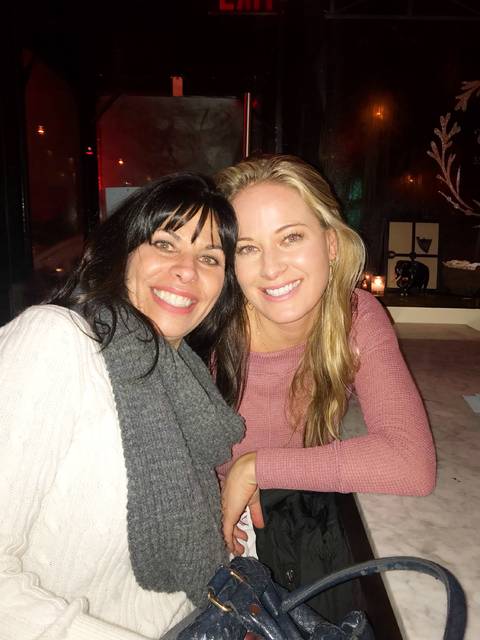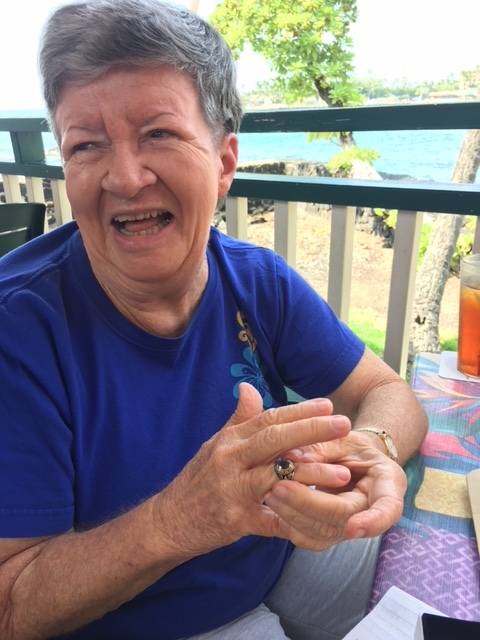Stephanie Ackerman thought she would never see her class ring again. And for nearly 50 years, she didn’t.
For her senior year at Honokaa High School, Ackerman received her Class of 1970 ring, a gold band set with a deep green peridot. But during a bus trip on the West Coast shortly after she graduated, Ackerman misplaced the ring at a bus stop and never saw it again.
Although Ackerman returned to Hawaii shortly thereafter, the ring’s journey was only beginning.
In August, Ackerman received a message from a New Jersey woman who found the ring as a child 40 years ago and had traced its origin back to her.
“It was quite a shock,” Ackerman said. “I couldn’t believe the whole thing.”
In a letter, the woman, Diane Fiumara-Chueiri, said she had chanced upon the ring on a family vacation as a 10-year-old child and had kept it ever since.
While walking the sands of Virginia Beach in 1977, Fiumara-Chueiri’s older sister felt an object beneath her toes. To their awe the sisters discovered a gold ring, displaying the legend “Honokaa Hawaii” and the engraved initials “M.S.A.,” and set with a beautiful green stone.
“I don’t remember how, but I ended up being the one with the ring,” Fiumara-Chueiri said, adding that she may have simply taken it from her sister’s room.
The ring ended up becoming a significant part of Fiumara-Chueiri’s life, she said. Although at first, it was merely a pretty piece of jewelry, as she became older and familiar with the concept of class rings, it became a symbol of maturity.
“I went to an all-girls high school,” Fiumara-Chueiri said. “And when we left school, the boys from the all-boys school would be gathered outside the entrance. And I would wear the ring to make them think I was a senior, that I was older than I was.”
“Of course, I couldn’t let them get close enough to read it, because Hawaii and Brooklyn are not at all the same,” she laughed.
Meanwhile, Ackerman moved to Kona, working on a ranch and eventually becoming a director of the Kona Historical Society, but she never stopped thinking about the ring.
“Every time I saw or heard about a ring, I would think of mine,” Ackerman said. Earlier this year, she said, she heard of a Canada woman who found a long-lost ring after it was discovered in her vegetable patch, bound around a carrot.
“I always hoped someone would find it,” Ackerman said.
Fiumara-Chueiri said she never really considered the origin of the ring, always assuming that a Hawaii woman — she suspected the ring to be a woman’s based on its size — had lost it at Virginia Beach. Only when she moved from Brooklyn to New Jersey in 1998, shortly after the birth of her first child, did she attempt to track down its original owner.
An initial online search easily found Honokaa High School, but there Fiumara-Chueiri’s search ended. She said she believed that a phone call to Hawaii would be too expensive, and anyway, she liked the ring.
“I always made sure I knew where it was,” Fiumara-Chueiri said. “I never kept in in a jewelry box or anything, it was always somewhere visible.”
Although she didn’t wear it, for about 20 years it sat on or around Fiumara-Chueiri’s desk, where she would see it every day.
“It really did mean something to me, even though it’s hard to pinpoint why,” she said. “I don’t really know what the bond was, but there was a connection there.”
Earlier this year, however, she tried again, this time reaching a woman at Honokaa High School. Using the initials and year on the ring, they were able to identify the original owner.
“It took weeks for me to put it in the mail,” Fiumara-Chueiri said. “I wanted to write a letter, but I didn’t want it to just be ‘I found your ring, here it is.’”
The letter, a handwritten account of how Fiumara-Chueiri found the ring and what it meant to her, dredged up half-forgotten childhood memories, Fiumara-Chueiri said.
“I loved the ring, I cherished the ring, but I didn’t know how much it actually meant to me until I wrote that letter,” Fiumara-Chueiri said. “It was very difficult for me to give it up.”
Ackerman said she went into “shock mode” when she learned of the ring’s survival.
“I never thought I would see it again,” she said.
Ackerman received the ring and Fiumara-Chueiri’s letter in the mail in November. The ring was in “perfect condition,” Ackerman said.
The two women spoke with each other by telephone the day after Thanksgiving, Ackerman said. Although the two had very little in common, they spoke for nearly an hour about their lives and what the ring meant to them.
Fiumara-Chueiri said she has felt drawn to Hawaii as a result of the ring’s mystique, taking her family on vacation to Maui several years ago. Ackerman, meanwhile, said she cannot leave the island anymore, due to scoliosis that makes prolonged travel very painful, but hopes one day to meet Fiumara-Chueiri in person.
As for the ring’s missing years between its disappearance and rediscovery, neither Ackerman nor Fiumara-Chueiri have any idea of what happened. Ackerman surmises that it was most likely taken by a woman, since it went missing in a women’s restroom, but beyond that, its full journey is unlikely ever to be known.
“She’s happy and I’m happy she’s happy,” Fiumara-Chueiri said. “But to me, I just returned someone’s ring. I had something that wasn’t mine and I gave it back.”
However, in their letters to each other, the women stopped referring to the ring as “Stephanie’s ring” or “Diane’s ring.” By the end of their stories, they each called it “our ring.”
Email Michael Brestovansky at mbrestovansky@hawaiitribune-herald.com








